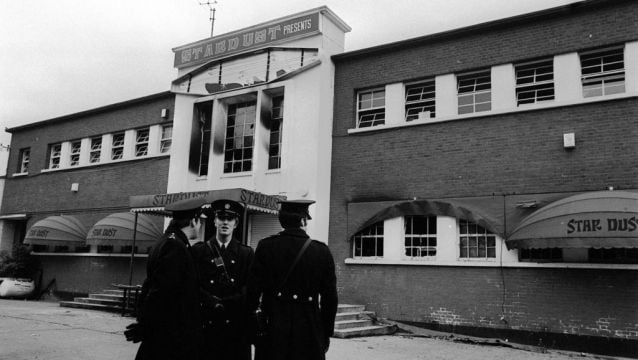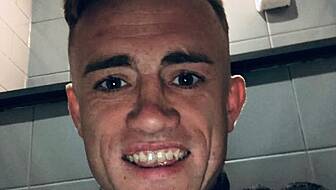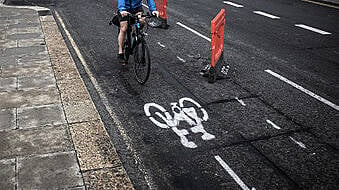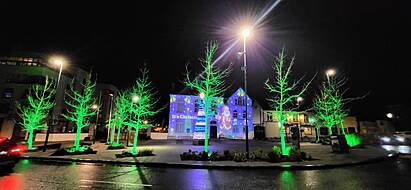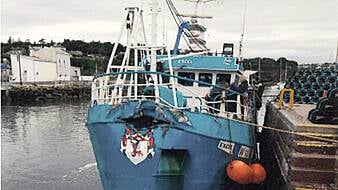A former senior firefighter has described the blaze that swept through the Stardust nightclub as “an accelerated fire”, telling an inquest jury that “there was something in that building that contributed to the spread” of the flames.
William McQuaid, a retired member of Dublin Fire Brigade, told the Dublin District Coroner’s Court that when he received the telephone call about the fire in the early hours of February 14, 1981, he was told that there was “a major accident plan” in force.
“It meant to me that the whole resources of the State were to be used to deal with this fire or incident,” Mr McQuaid on Wednesday told the inquest into the fatal fire that claimed the lives of 48 people when it consumed the nightclub in Artane, Co Dublin.
He told Simon Mills SC, a member of the coroner’s legal team, that when he arrived at the scene, he reported to Third Officer Joseph Kiernan, who was in charge of the fire and the fire ground (the operational area at the scene of a fire).
“He said he was up to his eyes in organising a temporary morgue at the side of the building, and he was also in contact with the control room organising as many ambulances that were in the city and county to respond there. He was also organising with CIE to send double-decker buses to take the walking wounded,” said Mr McQuaid.
Systematic search
He said Mr Kiernan instructed him to go into the main function area of the premises and make a systematic search of the whole area as the roof had collapsed, and all the debris that had fallen in could be covering people buried underneath it.
He said that he instructed sub officers to mark bodies with blankets, to indicate where there was a body so that the people with stretchers coming in would know where to go. He said he went to the first floor, where he found two female bodies lying on the landing.
“We immediately carried out an inspection to discover signs of life, pulses were felt for, heartbeats were checked for, breathing was checked for, and there was no response,” he said, going on to describe the blaze as “an accelerated fire”.
“I supported Mr Kiernan’s assessment that this was an accelerated fire. If a fire engine was passing by that building at the time people were running out of it, by the time they got to work to lay down hoses it would have made practically no difference, the fire was going so fast,” he said.
He said that the modern ceiling had collapsed and the ceiling on the old-structured building had collapsed, which indicated to him that “the temperature of this fire must have been way above the normal temperature”.
“It was a terrific temperature in that fire, in my opinion, from what I saw the damage that it did. The higher the temperature, the quicker the spread. It was not a normal speed in terms of what we were used to,” he said.
In response to questioning by Des Fahy KC, representing a number of the families of the victims, Mr McQuaid said that what contributes to the temperature of a fire is the amount of “combustible material” present.
“There was something in that building that contributed to the fast spread of that fire,” he said.
In response to a question from the jury, put to him by coroner Dr Myra Cullinane, Mr McQuaid said that the fire brigade ascertains the layout of a fire when they arrive at the scene by using their experience.
“You see the extent of the fire and make a judgement on that, and you get to work,” he said.
Mass of flames
The jury also heard the evidence of former firefighter Martin Messitt. In his original statement, which was read into the record by the court registrar, Mr Messitt said that he and another firefighter discovered a body with another body beside it.
“I do not know if the bodies were female or male due to the burnt condition they were in,” he said.
“When I first looked into the building, the place was a mass of flames. Any of the bodies that I helped to carry out were burnt beyond recognition. The clothes that they were wearing were burnt off their bodies,” he said, adding that the complete interior of the nightclub was completely gutted.
He told Mr Mills that he had never encountered a fire like that before. He told Seán Guerin SC, representing a number of the families of the deceased, that he spent ten to fifteen minutes fighting the fire.
He said that by the time he arrived as part of the second wave of firefighters, “there were pockets of fire everywhere”. He confirmed to Mr Guerin that “the damage had been done” by the fire before he arrived.
Evidence was also given by Brian Power, who at the time was an ambulance attendant. He told Mr Mills that the information he received on the night about the fire was “informal”, as his colleague was an amateur radio enthusiast and he had tuned the radio into the garda frequency, where they heard a lot of garda activity.
“I rang the switchboard operator to tell them something was going on in the north side of the city, and he told me he had received no information on it and that was the end of it. We continued to listen to the radio, and the garda radio traffic got more animated and urgent. Twenty minutes later I rang back to say there is some kind of a fire and it looks like it is serious, and again the switchboard operator informed me he had received no information,” said Mr Power.
Mr Power said he then made a clinical decision to override the switchboard operator and the ambulance he was in made its way to the Stardust.
He said that when they arrived, he was told that all patients were already gone. He said that the interior of the Stardust was “just a burned-out building” but he did not recall any flames at that time. He confirmed to Mr Mills that he found a body on the ground in the area of exit five and placed this body outside.
“We wanted to be of some value to the service at the time. A lot of the firefighters were busy, and when we found the body, we got a field stretcher to bring it out.
There were some other bodies outside on the ground. From my perspective, the bodies were just left where they were taken and in no particular order, and I just felt we needed to give some dignity to the bodies, so we lined up all the bodies and put blankets on them to give them some dignity,” he said.
He went on to confirm that he later took two bodies in his ambulance and transferred them to the city morgue, but he said that the bodies were not recognisable.
Dr Cullinane interjected to say that the bodies were later identified as those of Jacqueline Croker and James Buckley.
The inquest continues on Thursday in the Pillar Room of the Rotunda Hospital.
